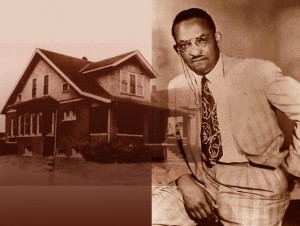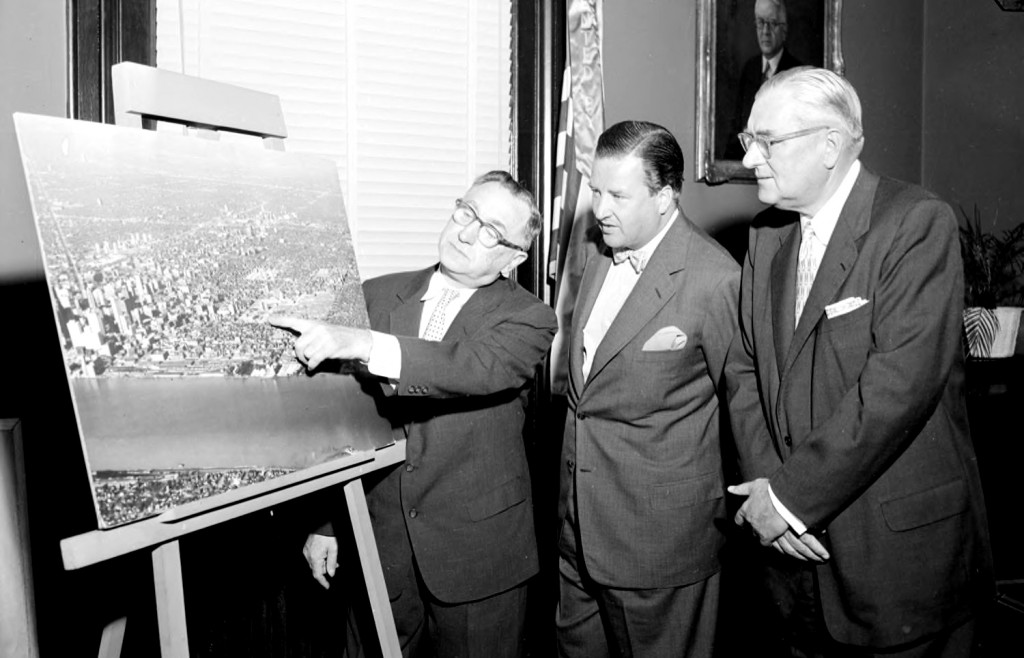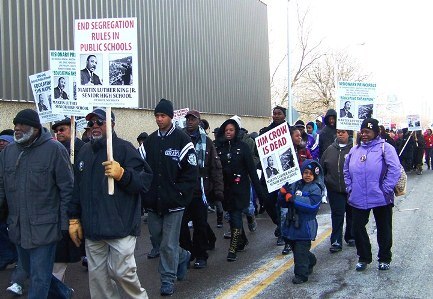The Detroit Emergency Manager: A Historical Look Vs. the Standard Version…
by Jamon Jordan (Notes) on Friday, June 14, 2013 at 11:03am
(VOD editor’s note: Story will be forthcoming shortly from VOD on Kevyn Orr’s meeting with the creditors, which we covered as seen in the photo above from the Detroit News. Meanwhile, this is an excellent article by Nsoroma Institute African Community Studies teacher and historian Jamon Jordan, published on his Facebook page.)
Okay, so the Detroit Emergency Manager, Kevyn Orr has said that he plans to give Belle Isle to the State (long term lease with administrative control over the island). He has also said that the Water Dept., which is the most powerful resource the city of Detroit has, will be surrendered to a private or regional entity and be refinanced so that the city’s control will be effectively ended.
Many applaud Orr as being a fiscally serious problem solver who is fixing what Detroit political leaders have been too lazy or inept to do for decades? But is THAT the case?
As a historian, I do NOT view present reality in a vacuum. One must take a HISTORICAL view to understand present-day conditions. So how REALLY did Detroit get in this financial quandary?

Dr. Ossian Sweet and his family’s house, which he defended from a white mob in the 1920’s. He was charged and later acquitted. His attorney was Clarence Darrow.
1.) In the early 1900s, Black people fled the South in what is known as the Great Migration. They were fleeing racism, sharecropping, lynchings and lack of political power and civil rights. They came to cities like Chicago, Cleveland, New York, Cincinnati and Detroit. This caused major racial tensions in the North. In Detroit in the 1920s, Dr. Ossian Sweet killed a white man who was part of a mob gathered outside of his house. In the 1940s, there were a number of incidents involving whites attacking Black people for moving in all-white areas. The most significant being the Detroit race riot of 1943.
2.) As a result of white supremacy, Henry Ford created a few white cities (Westland, Garden City, Wayne) so that whites would not have to live near the Black people who were working in his and other auto factories. However, this was not enough. So MORE suburbs were built and the federal government colluded with white leaders in Michigan to steer federal funds to build roads and highways that would lead whites out of the city to their federally financed homes, and INTO the city to their inner-city jobs. One of these freeways, I-75/375 was extended to downtown Detroit and destroyed the Black business district – Paradise Valley.

While Detroit Mayor Edward Jeffries may have initiated the Detroit Plan in the late 1940s, it was his successor Mayor Albert Cobo, 1950-57, (above, pointing) who pile-drived the idea into something tangible. Though regarded as a good mayor by 1950s standards, Cobo definitely set in place a social minefield of problems which would later explode on his successors. Perhaps history has granted him leniency because he died in office. Nevertheless, his failure to address the acute black housing problem may have pleased his constituents, but it was to spell doom for the city in the racial upheaval of the 1960s.
From: Detroit: The Blood Never Dried.
3.) The city, which was run by white leaders totally, took out loans to build roads, water infrastructure, and all the necessities so that white workers would have the amenities they needed in their new suburban digs.
4.) To afford to live in these suburban areas, the city employees needed FAT retirement packages and LARGE health care benefits. The white city leaders granted these packages forcing the burden on future generations of Detroiters and workers. Understand, that this is the 40s, 50s, & 60s, and the city workforce was nearly ALL-WHITE.

Northland Mall in 1954. It was built on Southfield swampland just outside the white northwest side of Detroit by the J.L. Hudson Company,
5.) At the same time, with whites moving to the suburbs at increasing speed, the tax monies the city received began to fall. Major retailers and manufacturers began to move to the suburbs because they KNEW that whites were beginning to stop shopping in Detroit, while at the same time, they knew that Black people WOULD venture to the suburbs in order to shop. At that time, suburban malls and shopping centers became the mainstay of suburbs and Detroit retailers began to fold one by one.
6.) The MAJOR retailers were then given MAJOR tax abatements in order to keep them in the inner city – General Motors, Ford Motor Company, Hudson’s, Michigan Bell, and so on…However, many of them took the money they saved from tax abatements and build mall stores and suburban shops and CLOSED their stores, thus abandoning Detroit and depleting the finances of the city.
7.) Detroit HAD to sell bonds to try and stay afloat. Wall Street knew that municipal bonds would be paid with interest even if a state/federal bailout was necessary, as what happened in New York City in the 70s. Wall Street effectively controlled the economy of the city for the last 40 years, and much of the so-called debt, is NOT to vendors, but to Wall Street billionaire investors and firms.
8.) John Engler, in a bid to corporations and conservative politics, made a deal with then-Mayor Dennis Archer in 1998. The state of Michigan would give Detroit $333.9 million annually for nine years in revenue sharing funds — if the city would ratchet down its highest-in-the-state city income tax rates. The city could have gained $700 million in additional funds in the period – for a city that has run repeated deficits (and piled up billions in bond & pension debt to compensate. Detroit lost $220 million worth of revenue sharing, plus $433 million to $508 million in income tax it wasn’t allowed to collect.
The next governor, Jennifer Granholm, had a failing economy and did not honor the deal, and no-Governor Rick Snyder, also acknowledges the deal, but refuses to honor following any part of it. Thus, at the very least, a half billion dollars due to Detroit is not forthcoming.
9.) Numerous corporations owe back taxes, and other fees to the city ofetroit. However, Wall Street has effectively forced Detroit to NOT go after these businesses, many of which are CLIENTS of the major Wall Street firms. If Detroit had vigorously sought to retrieve the missing dollars from these corporations (DTE, Chrysler, GM, Ford, AT&T, etc), Wall Street investors would have called in their bond markers which would have rendered Detroit bankrupt overnight.
10.) The reality is that Detroit’s emergency financial manager is NOT here to save the city. He is an agent not just of the state and Rick Snyder, but of the Wall Street investors and bond-holders who OWN Detroit’s debt. The same firms who bankrupted the nation in 2007-08, and destroyed the economy. At the same time, the rich and powerful are never made to feel the pinch of Detroit’s woes.
Whole Foods is now in Midtown because the city & state gave him tax abatements and development funds that will assure that the store makes money even if it never sells a thing. The deal for the tw0 Meijer’s Stores in Detroit is even larger.
When the Detroit Institute of Arts (DIA) was threatened with its PRICELESS collections being sold, which would have wiped out the city’s debt IMMEDIATELY (one Rembrandt in the DIA is reportedly worth $250 million), the rich and powerful, who CONTROL the DIA and view it as their living room, forced the state to pass a law almost overnight to prevent that from EVER happening. However, that law does not pass on the Charles H. Wright Museum of African American History, which has items that are PRICELESS in our history. They may very well be sold or taken into receivership.
The reality is, you don’t need to much of a historian or a media junkie to be aware that Emergency Managers and Emergency Financial Managers in Michigan have been largely unsuccessful in municipalities and school districts. No matter how they try to force-feed us fake fake facts, Robert Bobb and Roy Roberts have both failed to fix the finances of Detroit Public Schools. They have only been successful in giving large contracts to cronies, closing dozens of schools and giving many buildings away to charter schools and creating a rival district, the Educational Achievement Authority, that is FAILING. Numerous cities and school districts have had multiple emergency managers and/or have stayed in financial emergency for YEARS with the emergency manager being reappointed over and over again.
We must always challenge the standard narrative that is given to us in regards to what has happened. The standard version is generally speaking, a myth.
SOURCES:
1.) Arnesen, Eric (2002). Black Protest and the Great Migration: A Brief History with Documents.
2.) Gregory, James N. (January 17, 2007). The Southern Diaspora: How the Great Migrations of Black and White Southerners Transformed America.
3.) Wilkerson, Isabel (2010). The Warmth of Other Suns: The Epic Story of America’s Great Migration.
4.) Sugrue, Thomas (2008) Sweet Land of Liberty: The Forgotten Struggle for Civil Rights in the North.
5.) Sugrue, Thomas (2005) The Origins of the Urban Crisis: Race and Inequality in Postwar Detroit.
6.) Coontz, Stephanie (1992) The Way We Never Were: American Families and the Nostalgia Trap.
7.) Freund, David (2010) Colored Property: State Policy and White Racial Politics in Suburban America.
8.) Maura Webber Sadovi June 4, 2013, Wall Street Journal article, Whole Foods Bets Detroit (Whole Foods received about $6 million in city/state subsidies ) http://online.wsj.com/article/SB10001424127887324423904578523712663750112.html
9.) Robert Snell, Darren A. Nichols and Christine Ferretti June 14, 2013 – The Detroit Newshttp://www.detroitnews.com/article/20130614/METRO01/306140057#ixzz2WCc6mDaz
http://www.detroitnews.com/article/20130614/METRO01/306140057/EM-Orr-meets-creditors-plan-restructure-Detroit?odyssey=tab|topnews|text|FRONTPAGE
10.) Mark Stryker and John Gallagher Detroit Free Press June 2, 2013, Detroit Free Press http://www.freep.com/article/20130602/NEWS01/306020080/Detroit-bankruptcy-assets-sale-DIA














Interesting, no mention of Coleman Young or busing